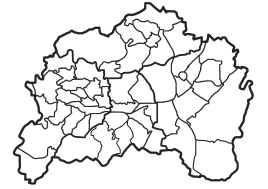Oege (Remscheid)
|
Oege
City of Remscheid
Coordinates: 51 ° 10 ′ 57 ″ N , 7 ° 18 ′ 27 ″ E
|
||
|---|---|---|
| Height : | 252 m above sea level NHN | |
|
Location of Oege in Remscheid |
||
Oege (form of Aue ) was a residential area in Remscheid (until 1975 in Hückeswagen ) in North Rhine-Westphalia (Germany). The place had been an industrial site since the 19th century and was flooded when the Wuppertalsperre was dammed from 1982.
Location and transport links
Oege was located in southeastern Remscheid in the statistical district of Engelsburg in the Lennep district in the Wupperaue south of Kräwinklerbrücke . The river formed the city boundary to Radevormwald here . Other neighboring towns were Dörpe , D Körperhöhe , Kräwinkel , Niederfeldbach , Hammersteinsoege and Felbeckerhammer . The place was on the route of the Wuppertal Railway , which crossed the Wupper here.
history
In 1481 the place was mentioned for the first time in a list of donations for the Marien Altar in the Hückeswagen church. Spelling of the first mention: In der Oye . The map Topographia Ducatus Montani from 1715 shows a farm with the name n.Oeu . In the 18th century the place belonged to the Bergisches Amt Bornefeld-Hückeswagen . 19 inhabitants lived in the village in 1815/16.
In 1832 Oege belonged to the Lüdorfer Honschaft , which was part of the Hückeswagen external citizenship within the Hückeswagen mayor . The place, categorized as a hamlet according to the statistics and topography of the Düsseldorf administrative district , had three residential buildings and five agricultural buildings at that time. At that time, 23 residents lived in the village, all of whom were Protestant.
In 1837 a Peter Daniel Gustav Sieper founded a company for the repair of agricultural machines and for the manufacture of file cutting machines in Oege , which later also produced shredders , carding grinders , stretching machines and other machines, especially for the Aachen industry. In 1889 the section Krebsöge - Radevormwald of the Wuppertal Railway was built. An iron truss bridge was built in the village to cross the Wupper.
In the municipality lexicon for the Rhineland province , three houses with 34 inhabitants are given for 1885. At that time the place belonged to the rural community Neuhückeswagen within the Lennep district . In 1895 the place had four houses with 27 inhabitants, in 1905 four houses and 20 inhabitants.
A steam engine was installed around 1900 and the factory was expanded to include assembly halls between 1906 and 1916. Also for the armor was produced at the factory in World War I grenades and World War II valves for submarines and bottom trays for tanks . In the post-war period, the company initially specialized in reconditioning defective textile machines, but then produced patented riveting machines with 40 workers .
On June 30, 1972, production was stopped due to the planned dam construction and the buildings were demolished between September 27, 1973 and January 29, 1974. This also included a timber-framed trading and office building, which was probably built in the first third of the 19th century and was inhabited by the Sieper family. With the construction of the Wuppertalsperre, the railway line was also shut down.
In the course of the North Rhine-Westphalian municipal area reform (§ 21 Düsseldorf Law ), the eastern area around Bergisch Born with the town of Oege was separated from the town of Hückeswagen on January 1, 1975 and incorporated into the town of Remscheid.
literature
- Siegfried Berg: The hamlet: Öge - Oege - Oye - Oeu, its history and its "downfall" . In: Leiw Heukeshoven 45. Hückeswagen, 2006, pp. 103–158.
Individual evidence
- ^ Klaus Pampus; First documentary mention of Oberbergischer places
- ↑ Johann Georg von Viebahn : Statistics and Topography of the Administrative District of Düsseldorf , 1836.
- ↑ a b c The company PDG Sieper in the Oege. 2004, accessed August 8, 2017 (private website).
- ↑ Königliches Statistisches Bureau (Prussia) (Ed.): Community encyclopedia for the Rhineland Province, based on the materials of the census of December 1, 1885 and other official sources, (Community encyclopedia for the Kingdom of Prussia, Volume XII), Berlin 1888.
- ↑ Königliches Statistisches Bureau (Prussia) (Ed.): Community encyclopedia for the Rhineland Province, based on the materials of the census of December 1, 1895 and other official sources, (Community encyclopedia for the Kingdom of Prussia, Volume XII), Berlin 1897.
- ↑ Königliches Statistisches Bureau (Prussia) (Ed.): Community encyclopedia for the Rhineland Province, based on the materials of the census of December 1, 1905 and other official sources, (Community encyclopedia for the Kingdom of Prussia, Volume XII), Berlin 1909.
- ↑ Entry on the industrial site Kräwinklerbrücke and Oege in the database " KuLaDig " of the Rhineland Regional Association , accessed on August 8, 2017.
